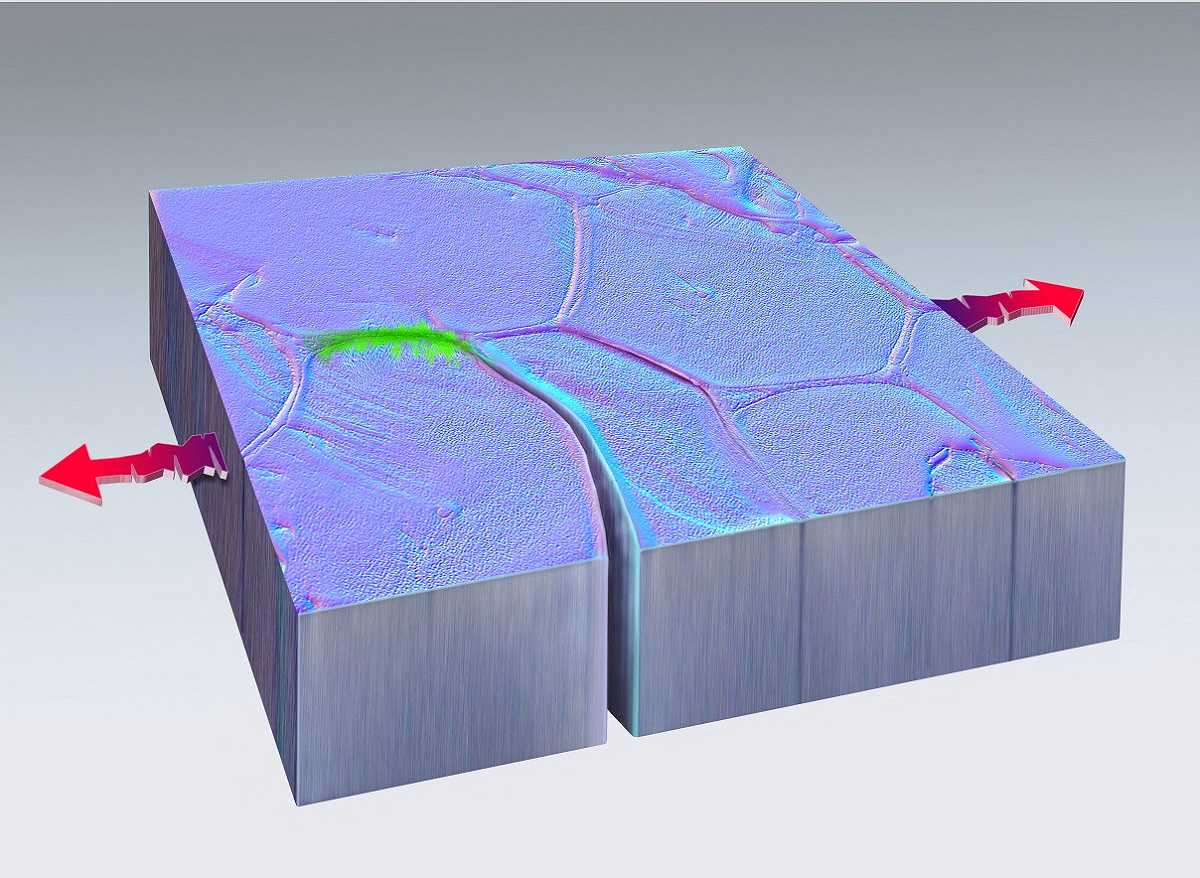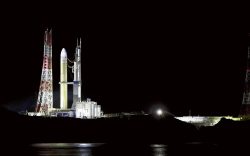
Researcher Ryan Schoell of the U.S. government’s Sandia National Laboratories in New Mexico uses a specialized transmission electron microscope technique developed by scientists Khalid Hattar, Dan Bufford and Chris Barr to study fatigue cracks at the nanoscale on Nov. 16, 2022.
18:19 JST, August 18, 2023
WASHINGTON (Reuters) — In the 1991 film “Terminator 2: Judgment Day,” a malevolent time-traveling and shape-shifting android called T-1000 that was made of liquid metal demonstrated a unique quality. Hit with blasts or bullets, its metal would heal itself.
Self-healing metal is still just science fiction, right? Apparently not.
Scientists on July 19 described how pieces of pure platinum and copper spontaneously healed cracks caused by metal fatigue during nanoscale experiments that had been designed to study how such cracks form and spread in metal placed under stress. They expressed optimism that this ability can be engineered into metals to create self-healing machines and structures in the relatively near future.
Metal fatigue occurs when metal — including parts in machines, vehicles and structures — sustains microscopic cracks after being exposed to repeated stress or motion, damage that tends to worsen over time. Metal fatigue can cause catastrophic failures in areas including aviation — jet engines, for instance — and infrastructure — bridges and other structures.
In the experiments at the U.S. government’s Sandia National Laboratories in New Mexico, the researchers used a technique that pulled on the ends of the tiny metal pieces about 200 times per second. A crack initially formed and spread. But about 40 minutes into the experiment, the metal fused back together.
The researchers called this healing “cold welding.”
“The cold welding process is a metallurgical process that is known to occur when two relatively smooth and clean surfaces of metal are brought together to reform atomic bonds,” said Sandia National Laboratories materials scientist Brad Boyce, who helped lead the study published in the journal Nature.

Green marks the spot where a fissure formed, then fused back together in this artistic rendering of nanoscale self-healing in metal, discovered at the Sandia National Laboratories, in this undated handout image. Red arrows indicate the direction of the pulling force that unexpectedly triggered the phenomenon.
“Unlike the self-healing robots in the ‘Terminator’ movie, this process is not visible at the human scale. It occurs at the nanoscale, and we have yet to be able to control the process,” Boyce added.
Metal pieces were about 40 nanometers thick and a few micrometers wide. While the healing was observed in the experiments only in platinum and copper, Boyce said simulations indicated that self-healing can occur in other metals and that it is “entirely plausible” that alloys like steel could exhibit this quality.
“It’s possible to envisage materials tailored to take advantage of this behavior,” Boyce said.
“Given this new knowledge, there may be alternative material design strategies or engineering approaches that could be devised to help mitigate fatigue failure. In addition, this new understanding may shed light on fatigue failure in existing structures — improving our ability to interpret and predict such failures,” Boyce added.
Scientists in the past have fashioned some self-healing materials, mostly plastics. Study coauthor Michael Demkowicz, a Texas A&M University professor of materials science and engineering, predicted self-healing in metal a decade ago.
Demkowicz correctly figured that under certain conditions, putting metal under stress that ordinarily should worsen fatigue-related cracks could have the opposite effect.
“My guess now is that tangible applications of our findings will take another 10 years to develop,” Demkowicz said.
“When I first made my predictions, some of the press said I was working on a T-1000. That’s still sci-fi,” Demkowicz said. “However, at the end of [TV series] ‘Battlestar Galactica,’ the crew adapted some Cylon [a fictional robot race] technology to help heal fatigue damage to their ship, making metal behave more like an organic tissue that can heal its own wounds. I’d say what we’re working on is more along the lines of the ‘Battlestar Galactica’ example.”
The self-healing was observed in a very specific environment using a device called an electron microscope.
“One of the big questions left open from the study is if the process also happens in air, not just the vacuum environment of the microscope. But even if it only occurs in vacuum, it still has important ramifications for fatigue in space vehicles, or fatigue associated with subsurface cracks that are not exposed to atmosphere,” Boyce said.
"Science & Nature" POPULAR ARTICLE
-

Genome Study Reveals Milestone in History of Cat Domestication
-

Big Leap in Quest to Get to Bottom of Climate Ice Mystery
-

Security Camera Footage Vulnerable to Outside Access; Investigation Finds 3,000 Pieces Exposed Online
-

Paws on Parade: Nairobi’s Dogs Dazzle at ‘Pawchella’
-

Japan Set to Participate in EU’s R&D Framework, Aims to Boost Cooperation in Tech, Energy
JN ACCESS RANKING
-

Keidanren Chairman Yoshinobu Tsutsui Visits Kashiwazaki-Kariwa Nuclear Power Plant; Inspects New Emergency Safety System
-

Imports of Rare Earths from China Facing Delays, May Be Caused by Deterioration of Japan-China Relations
-

University of Tokyo Professor Discusses Japanese Economic Security in Interview Ahead of Forum
-

Japan Pulls out of Vietnam Nuclear Project, Complicating Hanoi’s Power Plans
-

Govt Aims to Expand NISA Program Lineup, Abolish Age Restriction























